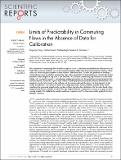Limits of Predictability in Commuting Flows in the Absence of Data for Calibration
Author(s)
Yang, Yingxiang; Herrera-Yague, Carlos; Eagle, Nathan N.; Gonzalez, Marta C.
DownloadYang-2014-Limits of predictability.pdf (1.580Mb)
PUBLISHER_CC
Publisher with Creative Commons License
Creative Commons Attribution
Terms of use
Metadata
Show full item recordAbstract
The estimation of commuting flows at different spatial scales is a fundamental problem for different areas of study. Many current methods rely on parameters requiring calibration from empirical trip volumes. Their values are often not generalizable to cases without calibration data. To solve this problem we develop a statistical expression to calculate commuting trips with a quantitative functional form to estimate the model parameter when empirical trip data is not available. We calculate commuting trip volumes at scales from within a city to an entire country, introducing a scaling parameter α to the recently proposed parameter free radiation model. The model requires only widely available population and facility density distributions. The parameter can be interpreted as the influence of the region scale and the degree of heterogeneity in the facility distribution. We explore in detail the scaling limitations of this problem, namely under which conditions the proposed model can be applied without trip data for calibration. On the other hand, when empirical trip data is available, we show that the proposed model's estimation accuracy is as good as other existing models. We validated the model in different regions in the U.S., then successfully applied it in three different countries.
Date issued
2014-07Department
Massachusetts Institute of Technology. Department of Civil and Environmental Engineering; Massachusetts Institute of Technology. Engineering Systems DivisionJournal
Scientific Reports
Publisher
Nature Publishing Group
Citation
Yang, Yingxiang, Carlos Herrera, Nathan Eagle, and Marta C. Gonzalez. “Limits of Predictability in Commuting Flows in the Absence of Data for Calibration.” Sci. Rep. 4 (July 11, 2014).
Version: Final published version
ISSN
2045-2322